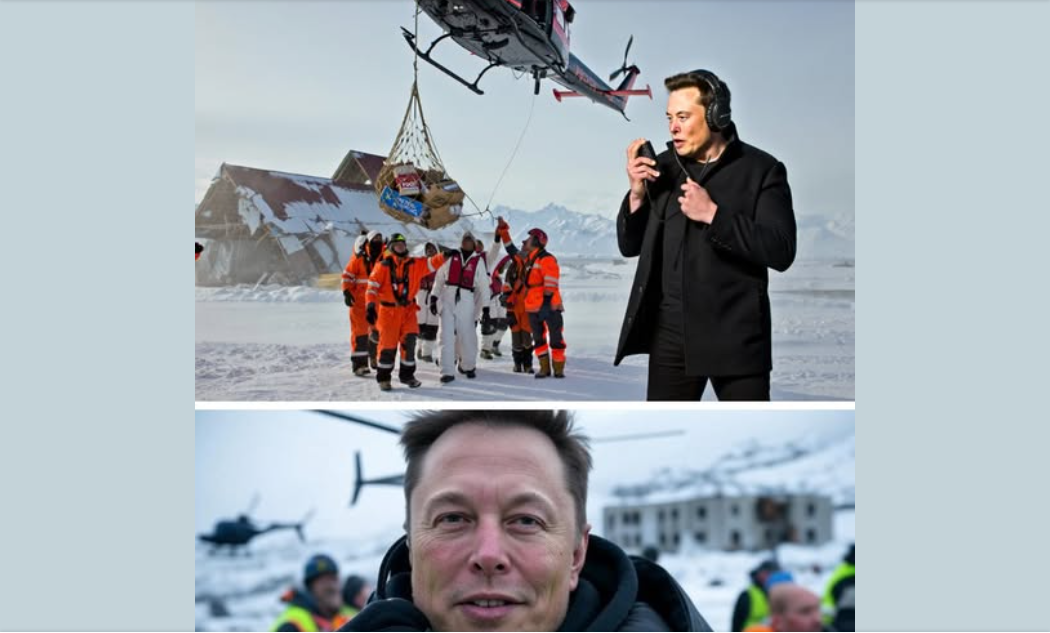
In a dramatic response to a devastating earthquake that struck Alaska on July 10, 2025, tech mogul Elon Musk has once again leveraged his resources to aid disaster-stricken communities, dispatching a helicopter loaded with food and medical supplies. The 7.2-magnitude quake, centered near Anchorage, left thousands without power, damaged infrastructure, and triggered landslides, prompting an urgent call for assistance. Musk’s swift action, facilitated through SpaceX and his personal network, has drawn both praise and scrutiny, highlighting his growing role in disaster relief amid his polarizing public persona. This article explores the earthquake’s impact, Musk’s intervention, the logistics of the relief effort, and the mixed reactions from the public and officials, based on recent developments as of July 17, 2025.
The Alaska Earthquake: A State in Crisis
The earthquake struck at 6:48 AM local time on July 10, 2025, with its epicenter 45 miles northwest of Anchorage, according to the U.S. Geological Survey (USGS). The temblor, the strongest in the region since 1964, caused widespread disruption, knocking out electricity to over 120,000 homes and businesses, collapsing parts of the Glenn Highway, and triggering landslides that buried remote villages. Initial reports from the Alaska Division of Homeland Security and Emergency Management indicated at least 15 fatalities and over 200 injuries, with rescue efforts hampered by damaged roads and severed communication lines. Governor Mike Dunleavy declared a state of emergency, mobilizing the National Guard and requesting federal aid from the Federal Emergency Management Agency (FEMA).
The quake’s aftershocks, numbering over 150 by July 12, compounded the chaos, with rural areas like Seward and Homer facing acute shortages of food, water, and medical supplies. Social media posts on X captured the devastation, with users sharing images of cracked buildings and stranded families, while local news outlets like Alaska Public Media reported on the struggle to reach isolated communities. The disaster underscored Alaska’s vulnerability to seismic activity, given its location along the Ring of Fire, and placed immense pressure on relief efforts as temperatures dropped.
Musk’s Helicopter Mission: A Swift Response
Elon Musk, known for his hands-on approach to crises, announced the relief effort on July 11 via X, stating, “Sending a chopper with Starlink, food, and medical gear to Alaska quake zones. SpaceX team is on it.” The mission involved a SpaceX-operated Sikorsky S-76 helicopter, typically used for executive transport, repurposed to deliver aid to hard-hit areas inaccessible by road. Departing from SpaceX’s Seattle facility, the helicopter carried 1,200 pounds of supplies, including dehydrated meals, portable water purifiers, first-aid kits, and Starlink satellite terminals to restore communication.
Musk’s decision was influenced by a direct appeal from Alaska Senator Lisa Murkowski, who contacted him after FEMA’s initial response was delayed by logistical challenges. The Anchorage Daily News reported that Musk coordinated with local authorities to identify drop zones, with the helicopter making its first delivery to Seward on July 12. Videos shared on X showed the chopper landing amid cheering survivors, unloading crates under the supervision of SpaceX engineers. A second flight to Homer followed on July 13, delivering additional supplies and setting up Starlink units, which provided internet access to emergency responders.
This marks Musk’s latest foray into disaster relief, following his deployment of Cybertrucks with Starlink during the 2025 Los Angeles wildfires and his controversial efforts during Hurricane Helene in 2024. His ability to mobilize resources quickly, bypassing traditional bureaucratic delays, has become a hallmark of his approach, though it often sparks debate about coordination with official agencies.
Logistics and Challenges
The helicopter mission showcased SpaceX’s logistical prowess, leveraging its aerospace expertise to address terrestrial crises. The Sikorsky S-76, equipped with advanced navigation systems, was chosen for its ability to operate in Alaska’s rugged terrain and poor weather conditions. FlightGlobal noted that the helicopter’s payload capacity and range allowed it to cover the 600-mile round trip from Seattle to Seward, with refueling stops at SpaceX’s Kodiak launch site. The Starlink terminals, weighing under 15 pounds each, were preconfigured to provide high-speed internet, a critical asset given the collapse of local cell towers.
However, the operation faced hurdles. Alaska’s unpredictable weather, including heavy rain on July 12, delayed the initial flight, while FAA regulations required temporary flight restrictions to be lifted, a process expedited after Musk’s direct call to Transportation Secretary Pete Buttigieg, echoing their 2024 Hurricane Helene discussions. X posts from @SpaceXUpdates claimed FEMA initially resisted the private mission, citing airspace concerns, though FEMA later clarified it welcomed all aid efforts with proper coordination. The rapid deployment nonetheless highlighted gaps in federal response, with some rural areas still awaiting FEMA supplies as of July 15.
Public and Official Reactions: Praise and Criticism
Musk’s intervention has elicited a polarized response. Survivors in Seward praised the timely aid, with one resident telling KTUU that the food drop “saved us from going hungry.” Senator Murkowski lauded Musk on X, calling him “a vital partner in this crisis,” while Governor Dunleavy thanked SpaceX for “bridging the gap” in relief efforts. The National Guard, overstretched by rescue operations, also acknowledged the supplies’ impact, with a spokesperson noting to Alaska Dispatch News that Starlink restored communication in Homer within hours.
Critics, however, question Musk’s motives and methods. FEMA officials, speaking to CNN, denied claims of blocking aid, asserting that their response was “robust” despite initial delays due to damaged infrastructure. Some X users, like @AlaskaTruth, accused Musk of grandstanding, with one post stating, “Musk’s helicopter stunt is just PR—where’s the real help?” Others pointed to his 2024 Hurricane Helene controversy, where he falsely claimed FEMA blocked Starlink deliveries, a narrative debunked by Transportation Secretary Buttigieg. The Alaska Democratic Party issued a statement urging Musk to work through official channels, arguing his independent actions risked undermining coordinated relief.
Media coverage has been mixed. The New York Times framed Musk as a “rogue philanthropist,” highlighting his ability to act where government faltered, while The Guardian cautioned against his “unregulated heroism,” citing potential safety risks from untrained personnel. The incident has reignited debates about private sector involvement in disasters, with some seeing Musk as a trailblazer and others as a disruptor.
Context: Musk’s Disaster Relief Legacy
Musk’s Alaska mission fits into a pattern of personal intervention in crises. In 2021, he sent a submarine to Thailand for a cave rescue (unused due to technical issues), and in 2025, he deployed Cybertrucks to Los Angeles wildfire zones, providing internet and power. His 2024 Hurricane Helene efforts, involving Starlink and helicopter deliveries, were marred by misinformation about FEMA, leading to a public spat with Buttigieg that was later resolved. These actions reflect Musk’s philosophy of using his companies—SpaceX, Tesla, and Starlink—to address immediate needs, often bypassing traditional aid structures.
His wealth, estimated at $424.7 billion by Forbes in May 2025, and his role as co-director of the Department of Government Efficiency (DOGE) under the Trump administration, amplify his influence. Yet, his hands-on style has drawn scrutiny, including a 2025 New York Times report alleging intensified drug use, which Musk denied on X. The Alaska mission, while lauded for its speed, raises questions about sustainability and accountability, especially as SpaceX balances relief with its $2.89 billion NASA lunar contract.
Implications and Future Outlook
The Alaska earthquake relief effort has bolstered Musk’s reputation as a rapid responder, potentially setting a precedent for private-sector disaster aid. SpaceX’s use of Starlink in Seward and Homer has proven its value, with local officials requesting additional units. Musk hinted on X at expanding the mission, stating, “More choppers incoming if needed—let’s get Alaska back online.” This could strain SpaceX resources, already stretched by Starship tests and ISS missions, but it aligns with Musk’s Mars colonization timeline, which relies on resilient infrastructure.
For Alaska, the aid has provided a lifeline, though long-term recovery will depend on FEMA and state efforts. The incident may pressure federal agencies to accelerate responses, while Musk’s involvement could inspire other billionaires to step in during crises. However, his approach risks clashing with official protocols, as seen in past disputes, and could complicate future collaborations.
Conclusion
Elon Musk’s decision to send a helicopter with food and medical supplies to Alaska earthquake victims on July 12, 2025, has been a beacon of hope for a state reeling from a 7.2-magnitude disaster. The mission, executed by SpaceX, showcased his ability to mobilize resources swiftly, delivering aid to remote areas like Seward and Homer. While praised by survivors and some officials, it has also sparked criticism over coordination and motives, reflecting the contentious nature of Musk’s disaster relief efforts. As Alaska rebuilds and Musk’s influence grows, this event underscores the potential—and pitfalls—of private-sector heroism in times of crisis.




